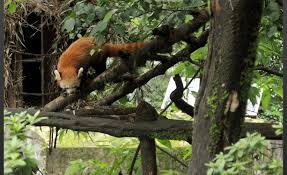India’s First Wildlife Biobank Opens at Darjeeling Zoo – A Landmark for Conservation
India has achieved a significant milestone in wildlife conservation with the establishment of its first zoo-based biobank at the Padmaja Naidu Himalayan Zoological Park (PNHZP) in Darjeeling, West Bengal. Operational since July 2024, this pioneering facility, often referred to as a ‘frozen zoo,’ is dedicated to the preservation of genetic materials from endangered species, marking a transformative step in biodiversity preservation.
Inception of the Biobank
The biobank at PNHZP was inaugurated in July 2024 through a collaborative effort with the Centre for Cellular and Molecular Biology (CCMB) under the Ministry of Science and Technology. This initiative aims to collect and preserve DNA, cellular, and tissue samples from endangered animals, as well as reproductive cells from deceased specimens. To date, the facility has successfully amassed genetic materials from 60 animals encompassing 23 distinct species. These samples are meticulously stored in cryogenic conditions at -196°C using liquid nitrogen, ensuring their viability for future research and conservation endeavors.
Significance of the ‘Frozen Zoo’
The establishment of this ‘frozen zoo’ is a monumental stride in the realm of wildlife conservation. By preserving genetic materials, the biobank serves as a safeguard against the extinction of endangered species, providing a reservoir of biodiversity that can be utilized for research, breeding programs, and potential species revival projects. This initiative not only enhances the genetic diversity of captive populations but also offers invaluable resources for scientific studies aimed at understanding and mitigating the impacts of environmental changes on vulnerable species.
Future Prospects and Expansion
Building upon the success of the Darjeeling biobank, plans are underway to establish similar facilities in other parts of the country. Notably, biobanks are proposed for the National Zoological Park in Delhi and the Nandankanan Zoological Park in Odisha. These expansions reflect a growing commitment to creating a network of genetic repositories across India, bolstering the nation’s capacity for wildlife conservation and research.
Padmaja Naidu Himalayan Zoological Park: A Legacy of Conservation
Established on August 14, 1958, the Padmaja Naidu Himalayan Zoological Park is renowned for its focus on the conservation and breeding of high-altitude wildlife species. The zoo has garnered international acclaim for its successful breeding programs involving the red panda, snow leopard, and Himalayan wolf. The introduction of the biobank further cements PNHZP’s status as a leading institution in wildlife conservation, dedicated to the preservation of the rich biodiversity of the Himalayan region.

Why This News Is Important
The inauguration of India’s first zoo-based biobank at PNHZP represents a pivotal advancement in the nation’s wildlife conservation efforts. This facility addresses the critical need for preserving the genetic diversity of endangered species, offering a strategic approach to combat biodiversity loss. For students preparing for government exams, particularly in sectors like environmental science, forestry, and wildlife management, understanding the functions and significance of such biobanks is essential. This development exemplifies the integration of scientific innovation with conservation strategies, highlighting the role of collaborative efforts between governmental bodies and research institutions in safeguarding natural heritage.
Moreover, the establishment of the biobank aligns with global conservation goals and reflects India’s commitment to fulfilling international biodiversity agreements. It serves as a case study on how infrastructural advancements can be leveraged to enhance conservation outcomes, providing a model that can be replicated in other regions. Awareness of such initiatives is crucial for future policymakers, conservationists, and educators, as it underscores the importance of proactive measures in environmental stewardship.
Historical Context
The concept of biobanking, particularly within zoological settings, has evolved as a response to the escalating threats of species extinction and biodiversity loss. The Padmaja Naidu Himalayan Zoological Park, since its inception in 1958, has been at the forefront of conservation efforts, specializing in the breeding of high-altitude species. The zoo’s commitment to preserving Himalayan fauna has been exemplified through successful breeding programs for species such as the red panda and snow leopard. The establishment of the biobank in 2024 represents a natural progression of PNHZP’s conservation mission, integrating modern scientific methodologies to enhance the preservation of genetic diversity.
Key Takeaways from the Establishment of India’s First Zoo-Based Biobank
| S.No. | Key Takeaway |
|---|---|
| 1 | Inception Date: The biobank at PNHZP became operational in July 2024. |
| 2 | Collaborative Effort: Established in partnership with the Centre for Cellular and Molecular Biology (CCMB). |
| 3 | Scope of Collection: Preserves DNA, cellular, and tissue samples from 60 animals across 23 species. |
| 4 | Cryogenic Preservation: Samples are stored at -196°C in liquid nitrogen to maintain viability. |
| 5 | Future Expansion: Plans are underway to establish similar biobanks in Delhi and Odisha. |
Important FAQs for Students from this News
What is the primary purpose of the biobank at PNHZP?
The biobank aims to collect and preserve genetic materials from endangered species to support conservation efforts, facilitate research, and potentially aid in species revival projects.
How are the genetic samples preserved in the biobank?
Samples are stored in cryogenic conditions at -196°C using liquid nitrogen, ensuring long-term viability for future use.
Which organizations collaborated to establish this biobank?
The biobank was established through a partnership between the Padmaja Naidu Himalayan Zoological Park and the Centre for Cellular and Molecular Biology (CCMB) under the Ministry of Science and Technology.
What future plans exist for biobanks in India?
There are plans to establish additional zoo-based biobanks at the National Zoological Park in Delhi and the Nandankanan Zoological Park in Odisha, expanding the network of genetic repositories across the country.
Some Important Current Affairs Links


















